In the book The Balanced Scorecard, by David Norton and Robert Kaplan, it is noted that 90% of organizations fail to execute their pre-set strategy.
This is a concerning statistic when you consider that, for a majority of companies considered successful, an emphasis is placed on having formal and pre-established systems to inform, manage, and meet their strategic obligations.
In this sense, can we not infer executing business strategy = business success?
To bridge this gap between strategic ambition and business performance, Process Street has created a Strategic Planning Template, which you can use – for free – right away!
By executing the steps given in this template you will not only develop good strategy, but the delivery of this strategy will also prove successful.
Click here to access our free Strategic Planning Template!
But to accommodate this template, you need to have a solid understanding of strategic planning itself.
In this article, I’ll discuss what strategic planning is, the different strategic planning models – with an emphasis on the Cascade Strategic Planning Model -, why strategic planning is important, and more.
Click on the links below to read through:
- What is strategic planning?
- Strategic management vs strategic planning: What is the difference between these 2 terms?
- Why strategic planning is important
- What are strategic planning models?
- Use Process Street’s strategy planning template to document your strategic plan
- Strategic plan outline: Framework, structure, and governance
- Other strategic planning models and how you can implement them via Process Street
What is strategic planning?
Strategic planning is a plan to execute business strategy.
To understand what strategic planning is, let’s break the term down into its constituent parts.
What is strategy?
“Strategy is the determination of the basic long-term goals of an enterprise, and the adoption of courses of action and the allocation of resources necessary for carrying out these goals.” – Strategy and Structure: Chapters in the history of industrial enterprise, Alfred D. Chandler
Strategy is a plan of action designed to achieve a long-term or an overall aim.
You can see how each task moves down the organizational hierarchy regarding what teams are involved. This is a key feature of the Cascade Strategic Planning Model to gets the whole organization involved to deploy your new strategy.
What is strategic planning?
Strategic planning is an umbrella term describing the processes used to establish long-term/overall goals. A strategic plan explains where the organization going and how the organization will get there.
For understanding, think of a strategic plan in terms of the following steps:
- An organization’s mission, vision, and values (overall direction of the organization) is defined
- Focus ideas and objectives are set
- Policies, projects, and plans are established to achieve objectives
- Metric measures and KPIs are used to assess performance
- Adjustments are made as necessary to stay on track
The strategic plan comes with the overall business plan, along with marketing, financial, and operating/management plans.
Strategic management vs strategic planning: What is the difference between these 2 terms?
Strategic planning is a term used more in the business world, whilst strategic management is used more-so in the academic environment – Strategic Management Insight, Strategic Management, and Strategic Learning
When researching the term strategic planning, you may have come across another term strategic management.
Strategic management and strategic planning are 2 separate terms, despite their interchangeable use, which can spike confusion when thinking about strategic planning. For this reason, I will take the time to define strategic management as separate from strategic planning, as despite the debate, subtle differences divide the jargon.
Let’s have a look at these differences…
According to USAID, both strategic management and strategic planning involve defining and outlining the mission and goals of an organization. As such, there is a lot of overlap between what the terms strategic planning and strategic management encompass. Never-the-less, slight but key differences separate the 2 apart. These differences have been summarized in the table below (this table has been adapted from Key Differences, The Difference Between Strategic Planning and Strategic Management).
In summary, strategic management is broader in scope, covering the active oversight of the strategic planning process. That is, strategic management devises and executes the specific steps to reach the goals defined by the strategic planning process.
| Basis For Comparison | Strategic Planning | Strategic Management |
|---|---|---|
| Meaning | Strategic planning sets priorities and determines an organization’s strategy with a future-orientated view. | Strategic management is broad in scope and involves a bundle of decisions, executed to achieve organizational goals set during the strategic planning process. |
| Stresses on | Making optimal strategic decisions | Producing strategic results, new markets, new products/technologies, etc. |
| Management | By plans | By results |
| Process | Analytical | Action-oriented |
| Function | Identifying actions to be taken | Identifying actions to be taken, the individuals who will perform the actions, the right time to act, and the way to perform the action. |
The development of strategic management as a discipline through the years
Strategic planning was born from strategic management, which was born by defining strategy in business.
Before the 1950s/60s, the term strategy was used in reference to war and politics, but not in business.
Post-war, many businesses began to build strategic planning functions.
My previous post, Hoshin Kanri: Gain a Competitive Advantage With This Lean Management Approach (Free Template), gives a good example of how strategy began to claw its way into the business realm. In this instance, the strategic planning model Hoshin Kanri was developed in Japan, a model originating from Samurai warfare ⚔️.
Over time, academics and business leaders developed on strategic management as a discipline, presenting new and improved models and theories, of which only the best survived to be in use today. Survivors include (but are not limited to):
- SWOT analysis
- Experience curve
- Corporate strategy/portfolio theory/growth-share matrix
- Porters five forces
- Value chain analysis
- Core competency
- Strategic planning process
These frameworks/models reflect an increased focus on cost, competitors, and customers in business over the years.
➡️ I have linked the relevant Process Street resources in the above list. Be sure to click on these links and check out these valuable sources ⬅️
Why strategic planning is important
“We are tackling 20-year problems with five-year plans, staffed with two-year personnel, funded by one-year appropriations.” – Harland Cleveland
The above quotation sums up why decision-makers in business must plan and manage strategically. And to do so is becoming increasingly more important, as I will explain.
In both developed and developing worlds, the rate of change is rapid. With greater openness in the political and economic environments, in addition to exponential technological advancements.
This rapid change has become more prominent in recent times – in light of COVID-19, and as the insistence of responding to our current environmental crisis becomes a priority.
With this change, there is a demand for a different set of business perspectives as the ones used in more stable times. Setting new business perspectives requires the re-evaluation of an organization’s strategy, to develop new strategies. For instance, a more environmentally conscious strategy, or strategies that are adapted and flexible in their response to global pandemics.
There is an escalating demand for strategy in our present-day unstable business environment.
With a strategic planning process, you’ll be assessing the current business situation, analyzing the availability of resources, organizational strengths, weaknesses, competitors, and the environment/industry in which you operate. This assessment means you are more equipped to respond to instability as appropriate, making better decisions to minimize business risk.
In addition to these larger-scale benefits, strategic planning also provides company-specific advantages, as listed below.
Strategic planning…
- Gives a sense of direction: Strategic planning defines the direction you want your organization to travel in, by aiding the establishment of realistic objectives and goals that are in line with an organization’s vision and mission.
- Increases productivity: Having a plan gives focus on what matters, and removes potential guesswork. As such, strategic plans create a foundation for productivity improvements.
- Increases durability and financial success: Corporations with an effective strategic plan in place have superior total returns for stakeholders.
- Cuts costs: An effective strategic plan – like the one you will produce via our Strategic Planning Template – could save your organization up to $1 billion.
- Introduces a proactive approach as opposed to a reactive one: A strategic plan enables your business to stay ahead of the change and on top of your competition. It allows a given organization to benefit from potential opportunities that present themselves in the market.
The importance of having a strategic plan in place doesn’t become more prominent until you consider what happens when companies plan poorly. In this next section, we will have a look at real-life examples of business strategy gone wrong.
Strategic planning examples: Strategic planning gone wrong #1, Iridium
Trigger warning: The below clip is from the movie American Sniper which is rated as certificate 15.
How is the above clip related to strategic planning?
Well, I was watching this movie a couple of weeks back – for the 11th time as its one of my favorites – and do you know what struck me?
Have a watch – what do you think?
Given by the subheader I am sure you noticed the heavyweight satellite phone Navy SEAL sniper Chris Kyle uses to make a call amid battle.
“Wow“, I thought – “Iridium is in Hollywood!”
Despite its star performance and $5 billion backed funding, Iridium and its wireless satellite phones were soon sniped out of business.
Customers rejected the high handset costs (~$3000) and $5 a minute per-call charges, resulting in the company filing for bankruptcy in 1999.
With a strategic plan to continually assess whether or not objectives are satisfied, Iridium could have foreseen the rise of smaller and cheaper cell phones – transmitting using land-based towers – and responded appropriately.
Strategic planning examples: Strategic planning gone wrong #2, eBay

Despite bringing in ~$10.75 billion in 2018, eBay hasn’t grown into its present-day success without challenges.
On the 10th birthday, the online auction site merged with the video-chat application Skype. This merger was thought to boost eBay’s customer value. However, Skype’s value dropped meaning eBay took on $1.4 billion in write-offs and other charges. The losses caused eBay to cut 10% of its workforce in 2008.
If eBay had an effective strategic planning process, could this error of judgment have been avoided?
Possibly. What is known that strategic planning places emphasis on the continual review of performance against set objectives. This means misalignment between expectations vs reality can be caught before an organization operates along an incorrect trajectory for too long.
What are strategic planning models?
A strategic planning model gives guidance and structure for the successful execution of strategy via a strategic plan. A strategic planning model takes into account the availability of business resources, whilst assessing the internal and external environments in which the company operates.
In this sense, the term strategic planning encompasses strategic planning models, but this inclusion is not exclusive.
The 3 principles of strategic planning
Strategic planning as a discipline comes from the broader academic practice named strategic management, which originated from strategic management in the 1950s/60s.
Since its inception, academic and practicing managers have developed numerous models and frameworks for strategic decision-making processes. These models take into account the complexities that come with a continuously changing business landscape.
A strategic planning model typically includes:
- Structure – This refers to how the different elements of your strategic plan fit together. For instance, objectives are set concerning your vision. Structure refers to how the different components of your business strategy relate to one another.
- Framework – There are different methodologies you can use during your strategic planning process. For instance, SWOT analysis and the PDCA cycle are to name 2. Some of these methodologies are mentioned in this article. Framework refers to the methodologies you use to achieve your strategic goals.
- Governance – Strategic planning places emphasis on tracking, reporting and continuously improving your business processes. Governance is how you go about doing this. In essence, governance is the overall management of your strategy.
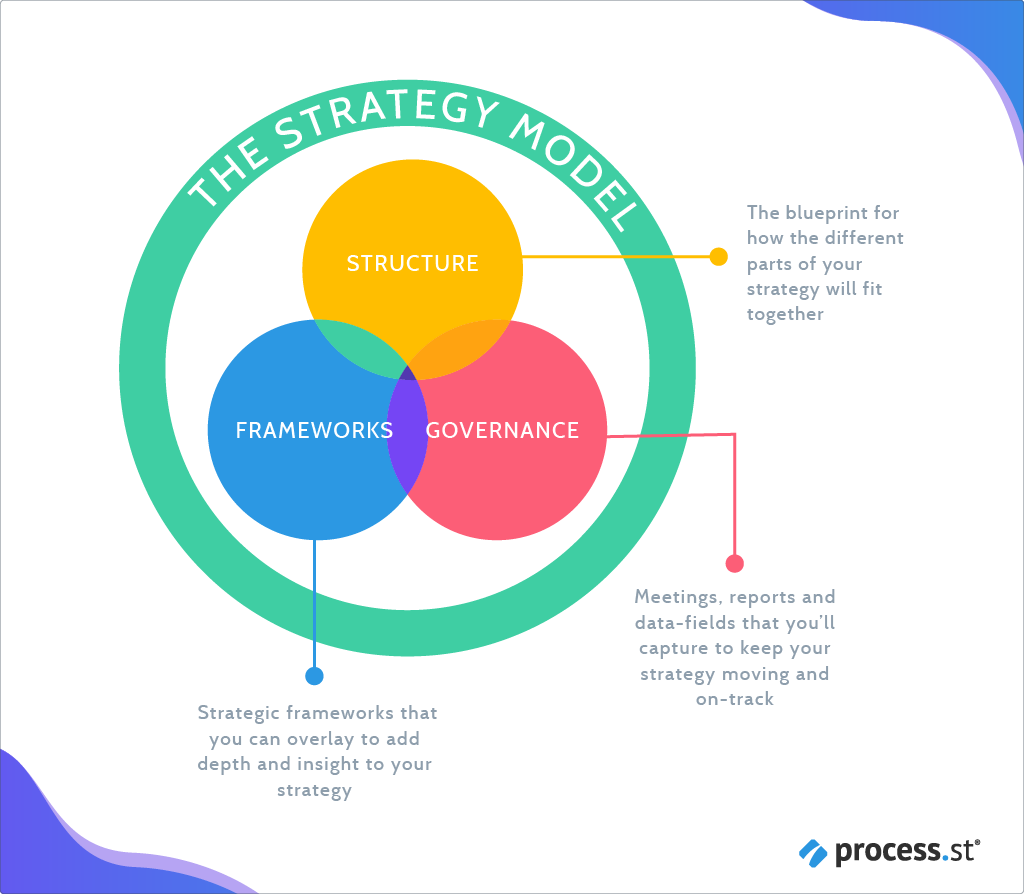
All three principles – framework, structure, and governance – are vital for a strategic planning process. For this reason, at Process Street we recommend you select a strategic planning model that contains all three principles. With lots of models out there, this narrows options down for you.
1 top strategic planning model you should consider is the Hoshin Kanri methodology. For this model, read my previous article: Hoshin Kanri: Gain a Competitive Advantage With This Lean Management Approach (Free Template). My article tells you everything you need to know about Hoshin Kanri. To implement this strategic planning model, use our Hoshin Planning: Hoshin Kanri Policy Deployment Process Checklist, embedded below.
Click here to access our Hoshin Planning: Hoshin Kanri Policy Deployment Process Checklist for free!
Switching our focus from the Hoshin Kanri methodology, we move forward in this article and turn our attention to another top strategic management model, the Cascade Strategic Planning Model.
This model is simple enough to understand, and can easily be implemented to execute your business strategy. Using the cascade approach, your corporate strategy is communicated down to the functional level, giving a great amount of clarity for your teams. Seeing activities that must happen at their level, and how that activity connects back to the overall plan is critical for organizational alignment.
Once more – like the Hoshin Kanri approach – the Cascade Strategic Planning Model is:
- Not too complicated: Users of the model do not get lost in jargon. The model focuses on execution and therefore removes unnecessary complexities.
- Scalable: The model can be applied to both small and large organizations.
- Is flexible: This one is pretty self-explanatory. The model is adaptable and can be used in different situations/circumstances.
- Is tangible and measurable: Success is measured using Key Performance Indicators (KPIs).
For these reasons, I recommend you consider both the Hoshin Kanri approach alongside the Cascade Strategic Planning Model and see which model works best for you. We already have a dedicated article on Hoshin Kanri – mentioned above – so for this article, I focus solely on the Cascade Strategic Planning Model.
You are provided with Process Street’s Strategic Planning Template for the practical implementation of the Cascade Strategic Planning Model.
Use Process Street’s Strategic Planning Template to document your strategic plan
A strategic planning template outlines each step needed to document and follow an intended organizational direction. It tells you how to implement your intended business strategy.
Due to the non-static nature of Business, strategic-management models must be dynamic, with feedback loops to monitor execution and inform one planning round after the next.
In addition, successful strategic planning involves team-wide effort from an organization’s internal team, external vendors, and other outside people. That is, strong communication channels are vital to ensure that objectives and strategies are effectively developed and disseminated throughout the company.
Process Street’s Strategic Planning Template has been created taking all of the above into account. Once more, this template is free and ready for you to use right away.
Our template has been developed using Process Street’s top features such as:
- Stop tasks to ensure task order.
- Dynamic due dates, so no deadline is missed.
- Conditional logic, creating a dynamic template that caters to your needs.
- Role assignments, to ease task delegation within your team.
- Approvals, allowing decision-makers to give the go-ahead (or rejection) on important items. Also, the necessary comments can be provided.
- Task assignments, to assign users and groups to individual tasks in your checklists. This makes it easy to see who is responsible for what.
- Embed Widget, allowing you to view and interact with other apps without leaving your checklist.
You will see specific examples of how our features add value to our Strategic Planning Template below, so keep reading. In a general sense though, these features make our checklists dynamic and adaptable and therefore highly suited to the ever-changing business landscape.
Strategic Planning Template
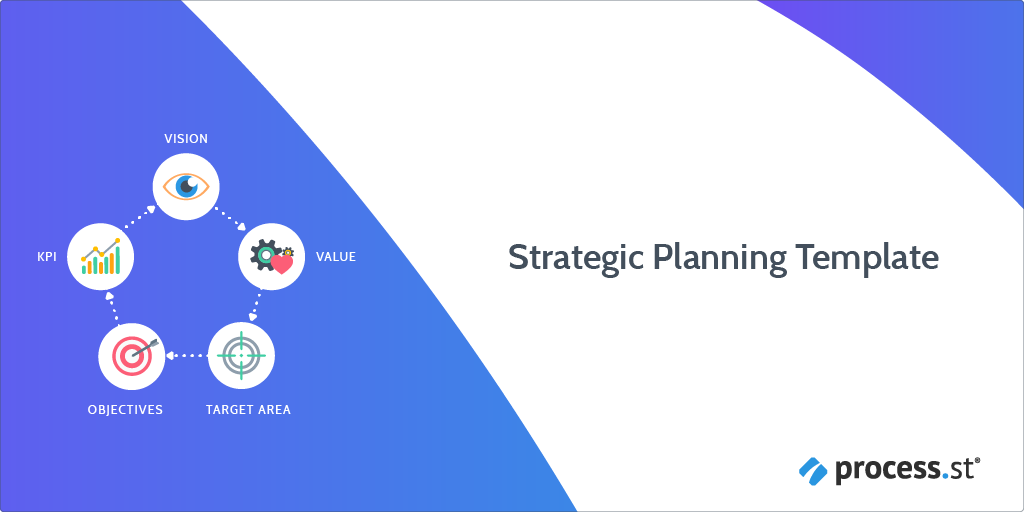
Think of our Strategic Planning Template as your business roadmap and compass, to relocate your corporate position, leading the way for business success.
By using this template you will close the gap between your current state and where you want to be in the future utilizing the Cascade Strategic Planning Model.
Sounds good right?
Click here to access our Strategic Planning Template!
Strategic plan outline: Framework, structure, and governance
Before jumping into our Strategic Planning Template, use this section to familiarize yourself with the Cascade Strategic Planning Model by considering this model’s strategic plan outline.
It is important to understand the model before applying it, to prevent errors, confusion, and wasted time.
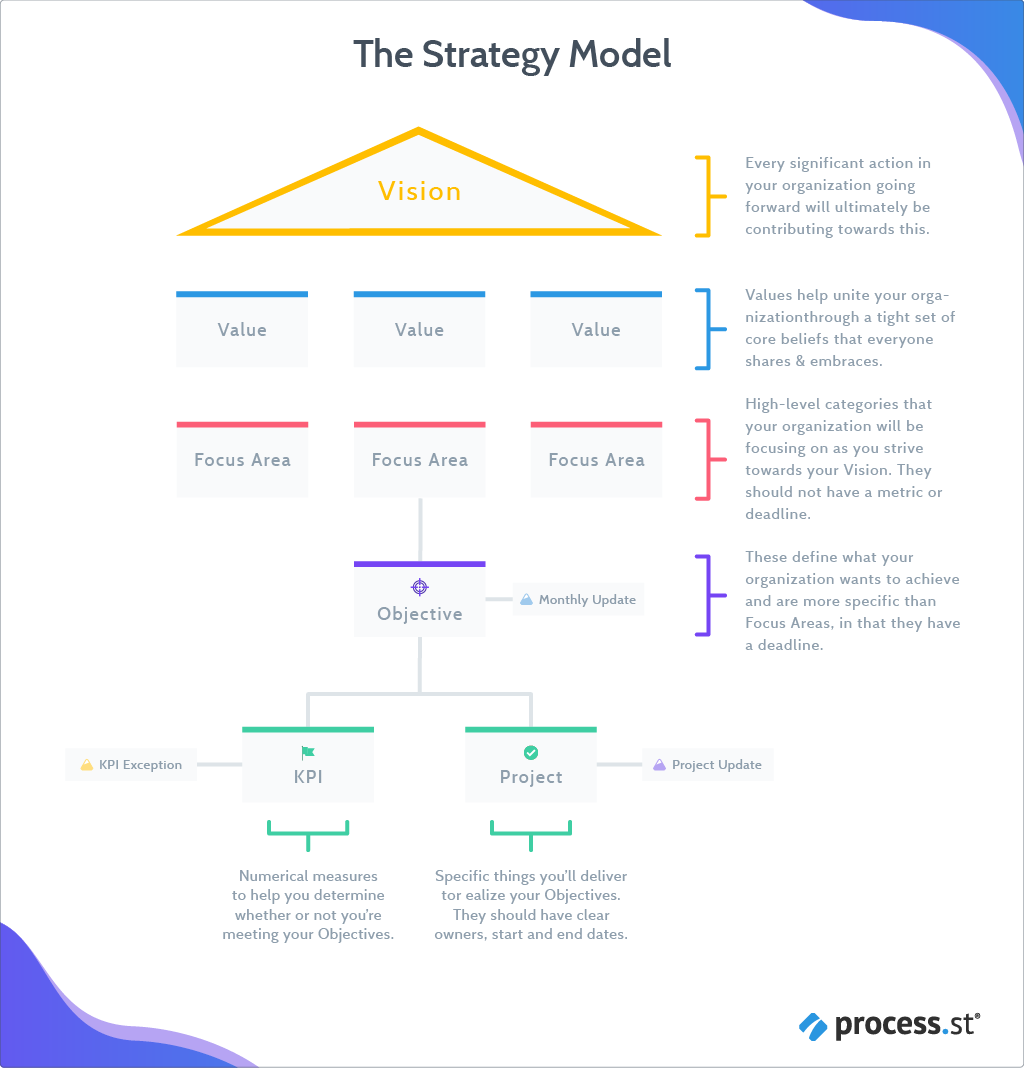
Let’s examine the 3 principles – framework, structure, governance – in relation to the Cascade Strategic Planning Model.
Framework ✏:
- The Cascade Strategic Planning Model is framework agnostic. This means you can apply several different frameworks to help you achieve your goals.
Structure :
- Identification of your mission statement: Your mission statement describes why the organization exists. Your mission statement can evolve.
- Defining values: Your values describe how you want your organization to behave.
- Establishing focus areas: Your identified focus areas define the business division receiving your focused effort.
- Creation of objectives: Objectives detail the outcome you want to achieve for each focus area.
- Defining KIPs: Each objective should contain at least 2 KPIs. You use your defined KPIs to measure whether or not you’re close to reaching your desired outcome.
- Project specifications: Project specifications are the actions you will take to deliver on your set objectives.
Governance :
- Monthly Strategy Updates: Performance is tracked for each objective to check performance.
- Project Updates: Ad hoc updates are made for each project via comparing project plans with reality. Project updates include general updates and progress.
- KPI Exceptions: When KPIs are outside the tolerance level, an explanation is needed along with a detail of actions to be taken to address the gap.
In our Strategic Planning Template, we have split the strategic planning process into 3 phases. To aid your understanding of the Cascade Strategic Planning Model and hence how to use our Strategic Planning Template, we will work through a hypothetical scenario together.
Hypothetical scenario: You want to break into the fashion market with a new, sustainable brand of clothing. You take second-hand clothes, fix-them-up, re-brand them, and sell them on (so like eBay on steroids).
To break into the fashion industry, you need a strategy.
Lucky you, as you have signed up to Process Street and have full access to our Strategic Planning Template.
Let’s run a checklist, and get started with your strategic plan .
Strategic planning, phase 1: The discussion phase
This phase is all about gathering information to decipher where you are at present. The discussion phase involves talking with internal and external stakeholders, in addition to conducting industry analysis.
It is recommended that the SWOT framework is used to conduct the industry analysis needed. The purpose of SWOT analysis is to examine an organization, business, or project using the four attributes:
- Strengths
- Weaknesses
- Opportunities
- Threats
Use Process Street’s SWOT Analysis Template in conjunction with our Strategic Planning Template to ensure you are conducting a thorough industry analysis as needed.
Click here to access our SWOT Analysis Template!
Let’s jump back into our hypothetical example. We begin our strategic plan by documenting the executive summary. Detailing the executive summary is important, as, with this, you can make comparisons between where you currently are – detailed in the executive summary – to where you are after X years.
In this case, we want to re-define the fashion industry, to create an industry with minimal waste and centered around the three R’s – Reuse, Reduce, and Recycle. Coming back to the executive summary after having followed our strategic plan will allow progress to be measured against this mission.
Due to the importance of detailing an executive summary, this is a stop task meaning progression in the checklist cannot be made until an executive summary is documented.
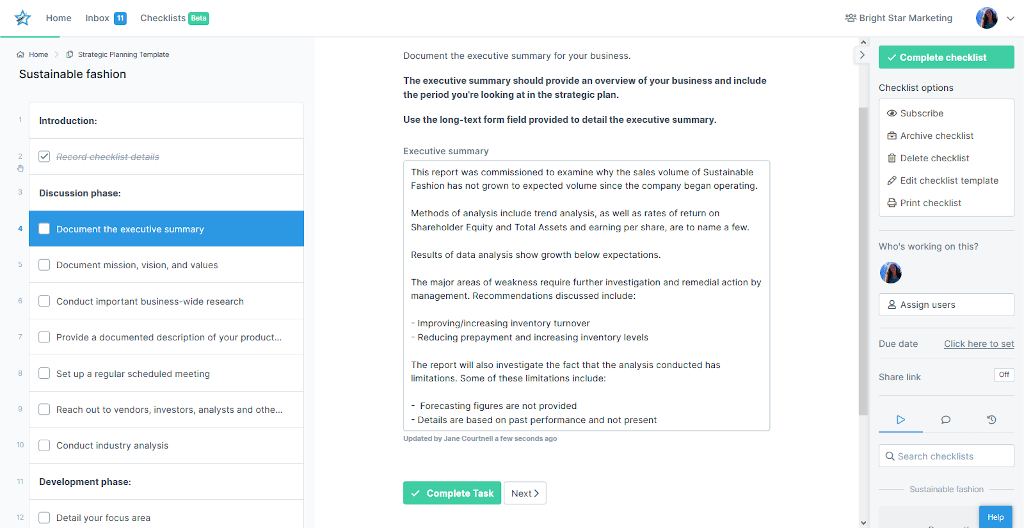
Next, you move onto defining your company’s mission, vision, and values. This helps guide correct strategic direction.
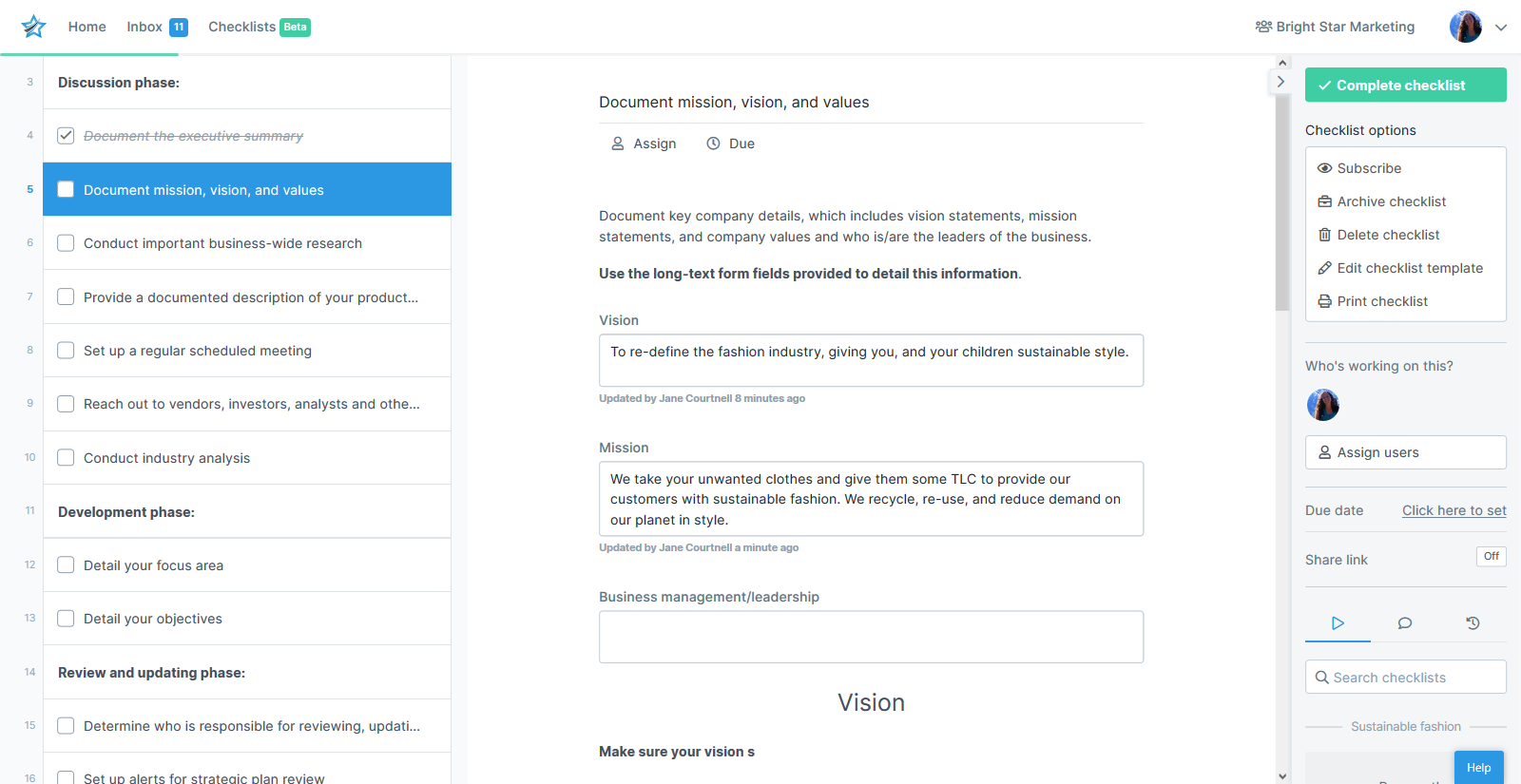
The next steps of the discussion phase involve identifying:
- Clients
- Customers
- Competitors
And then describe the following:
- Industry – which is the fashion industry in this scenario
- Products
- Suppliers
- Delivery system
All this information is then communicated to your team via team meetings.
Here you have the option of using Process Street’s Embed Widget to send an email reminder to team members with information regarding the meeting time and date. Keep your team in the loop without having to jump from one application to another.
Note: It is towards the end of the discussion phase where you will open and use Process Street’s SWOT Analysis Template.
Strategic planning, phase 2: The development phase
In the development phase, you begin putting together your business’s strategic plan. Start by identifying your company’s focus areas. Identifying focus areas streamlines your attention preventing your strategy to run off on a tangent.
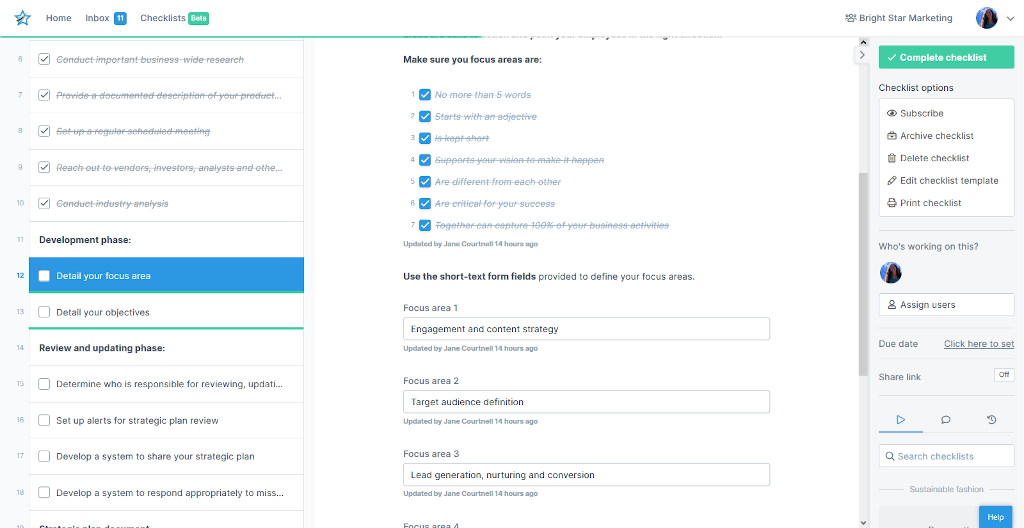
Next, define your objectives and group them as per the related focus area. It is important to begin your objectives with a verb to inspire action.
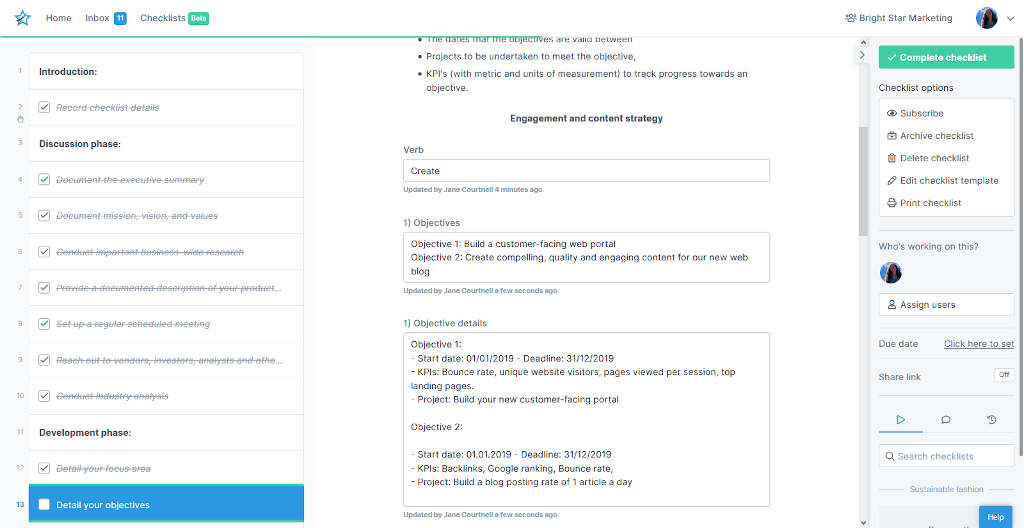
Under each defined objective, state the KPIs, in addition to the associated projects and objectives (with start dates and deadlines noted). All this information compiled is in essence your plan of action that will take your business to where you want it to be.
Strategic planning, phase 3: The review and updating phase
The final phase of our strategic planning process is the review and updating phase. Begin by assigning the individual responsible for reviewing and updating your strategic plan. This assignment uses our task assignments feature, notifying the relevant personnel of their task automatically.

As you run through the review and updating phase, you are encouraged to:
- Manage organizational change appropriately: By developing and implementing a new strategic plan for your organization, you are introducing business change that needs to be managed appropriately. To help you manage this change effectively, Process Street has created 9 top change management model templates, which you can access, for free ➡ here ⬅.
- Adopt a continuous cycle of check, plan, do, act: Strategic planning is all about assessing your current status, analyzing what is working and what isn’t, and making the changes as appropriate. For instance, you may miss a given objective before the objective deadline. In reaction, adopt a system that identifies the problem, and guides you to a solution. At Process Street we recommend you use our PDCA Cycle Change Management Model Process Checklist for this. Details of this checklist are given below.
Our PDCA Cycle Change Management Model Process Checklist gives an iterative 4 step process, designed to manage business processes for continual improvement. The model is also referred to as the Demming Cycle.
The PDCA Cycle Change Management Model Process Checklist provides a simple and effective approach for solving problems that present themselves when a given objective has not been reached.
The model is best used for testing and improving measures on a small scale, before updating procedures and working methods.
Click here to access our PDCA Cycle Change Management Model Process Checklist!
At the end of our strategic planning process, all key information is compiled into your strategic plan summary. This summary is reviewed and approved by the relevant manager before you write up the information into your official and final strategic plan report.
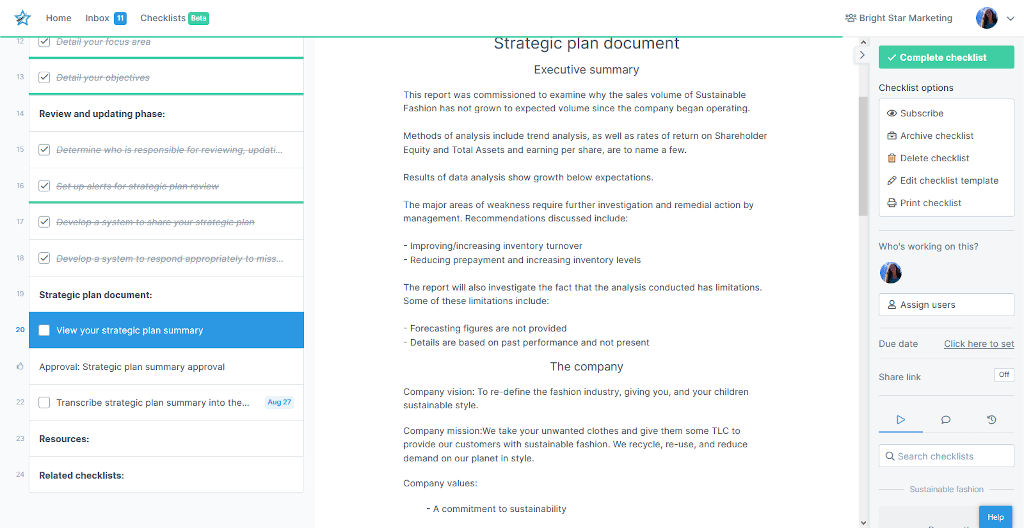
In your strategic plan summary, you can view your action plan, which details your objectives along with their associated objective details. Refer back to this action plan at any point during the planning process.
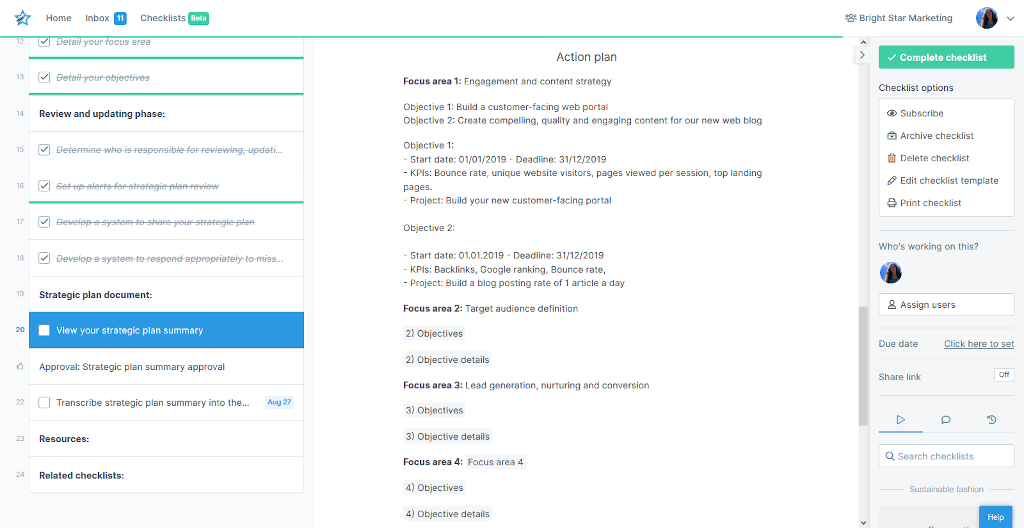
The plan summary needs to be approved by the relevant personnel. This can be done via Process Street’s approval feature. A notification for approval is sent to the relevant personnel on your team automatically, keeping the whole process streamlined.
Other strategic planning models and how you can implement them via Process Street
Process Street is superpowered checklists.
So far, Process Street has introduced you to 2 top strategic planning models and our associated checklists to go with them:
- The Hoshin Kanri approach, which you can implement for free using our Hoshin Planning: Hoshin Kanri Policy Deployment Process Checklist,
- The Cascade Strategic Planning Model, which you can implement via our Strategic Planning Template.
However, there are more models you should consider employing!
Going into detail on each model is beyond the scope of this article. However, I have provided useful resources that explain these different models in detail. Have a look through these resources and think about how you can transcribe any one of them into a Process Street checklist – as we have done for the Hoshin Kanri approach and the Cascade Strategic Planning Model.
Which model/s you decide to use is personnel to you and your business/line of work.
- The Balanced Scorecard
- Objectives and Key Results (OKR)
- Theory of Change
- PESTLE Analysis
- Visioning
- VRIO Framework – we have a ready-made checklist you can use for free. Check out our VRIO Analysis Checklist
- Using and validating the strategic alignment model
- Scenario strategic planning
- Organic strategic planning model
For more information on how you can create and edit checklists in Process Street, watch the below video: Basics of Creating and Editing Templates.
Execute an effective and efficient strategic planning process with Process Street
Strategic planning is vital to sustaining business success in today’s ever-increasingly unstable corporate environment. Highlighting the failures of Iridium and eBay only emphasizes this point.
Using Process Street and our superpowered checklists make the strategic planning process easy for you. You can transcribe any strategic planning model into a Process Street checklist, for free, once you have signed up and created your Process Street account.
How do you plan strategically for your business? What model/s have you used? Please comment below as we would love to hear from you. Who knows, you may even get featured in an upcoming article!








Jane Courtnell
Hi there, I am a Junior Content Writer at Process Street. I graduated in Biology, specializing in Environmental Science at Imperial College London. During my degree, I developed an enthusiasm for writing to communicate environmental issues. I continued my studies at Imperial College's Business School, and with this, my writing progressed looking at sustainability in a business sense. When I am not writing I enjoy being in the mountains, running and rock climbing. Follow me at @JaneCourtnell.